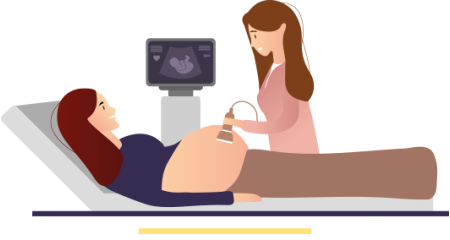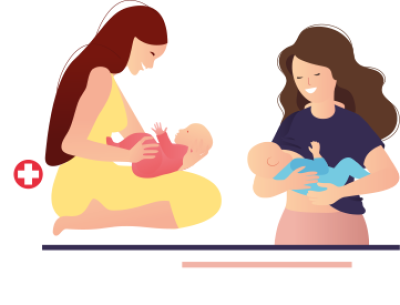The process
Every childbirth goes slightly differently, but we can tell you more about the process and what you can usually expect.
Mucus plug
During pregnancy, the womb is sealed with a mucus plug. At the end of your pregnancy you might lose this, often along with some bleeding. This does not necessarily mean you are about to go into labour. Some women do not notice the loss or only lose the plug during childbirth. Don’t worry, if you lose the mucus plug you don’t need to do anything – simply wait until you are really going into labour.
Water breaking
In 10% of cases, labour begins with the water breaking. The amniotic fluid can be bright white, clear, pinkish with flecks, green or brown. You might lose a lot of fluid all at once, or small amounts when you move. You will usually go into labour within 24 hours of your water breaking. If this has not happened after 24 hours, it will be managed at the hospital.
Dilation
Contractions are usually brief and irregular at first. Keep track of how frequently your contractions are occurring and how long they last. Try to keep yourself distracted for as long as possible. This is just the beginning and the contractions might still decrease. If you are having contractions every 3-5 minutes for an hour, then you are probably going into labour. This is the best time to call us. We will come to you and determine how dilated you are. We will arrange with you when we will come back or when we will go to the hospital. In the last phase of dilation we will stay with you to manage the birth further.
When your contractions have properly started, it is important that you try to relax as much as you can. Try to find postures and positions that allow you to handle the contractions better, for example walking, lying down, in bed or in the shower. We check your progress constantly and support you throughout the process. Let us know what you need, so that we can help you in the best possible way.
Pushing
At 10cm dilation the contractions transition into pushing contractions. You will often experience an unbearable urge to push. When the baby has descended sufficiently, you can start to push. With each contraction the baby moves further along the birth canal, and then slides a little bit back again. At the end of the pushing phase, a large part of the head will be visible, and will not move backwards anymore. This can be very painful, but usually doesn’t last long. After this, the baby will be delivered.
Afterbirth
After the baby is born, the placenta also needs to be delivered. This usually happens within 15 minutes. You might continue having contractions, which help detach the placenta. If necessary, your midwife will give you an injection to ensure that the placenta is delivered quickly and to reduce blood loss. Once the placenta has been delivered, the contractions will usually fade away. You may experience after-contractions, which you can manage with paracetamol.








